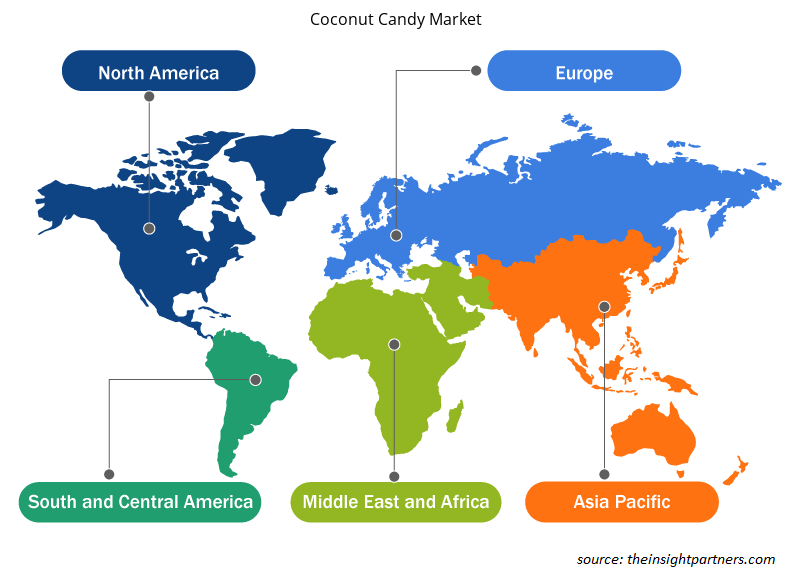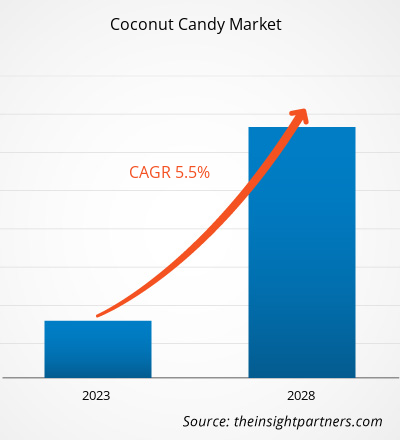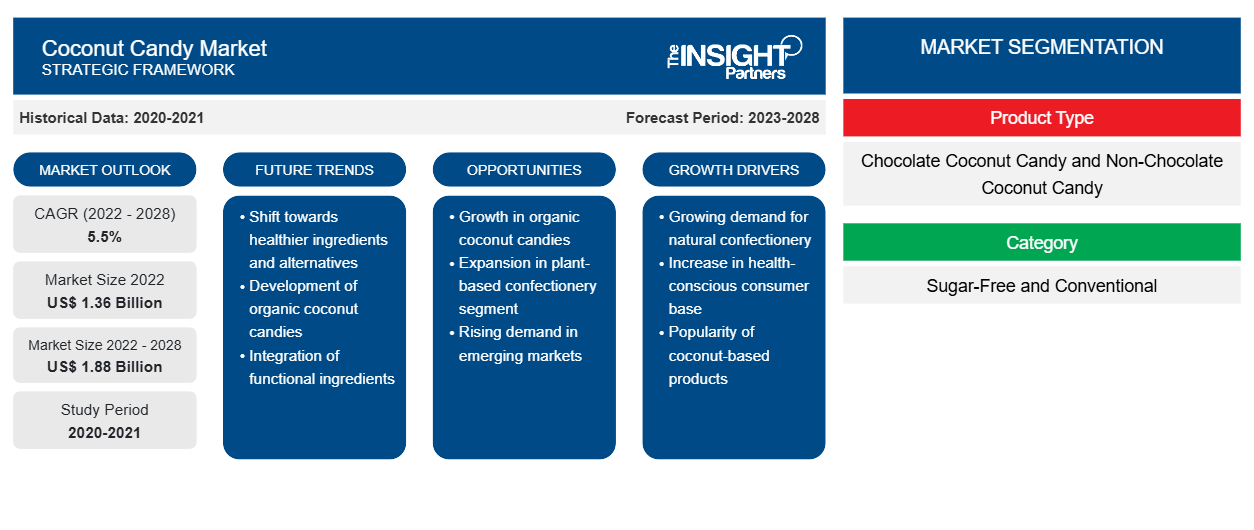Se espera que el mercado de dulces de coco crezca desde US$ 1.364,87 millones en 2022 y se espera que crezca a una CAGR del 5,5% entre 2022 y 2028.
El coco se asocia con una variedad de beneficios para la salud. Es rico en vitaminas, minerales, carbohidratos, triglicéridos de cadena media y fibras dietéticas, que ayudan a mejorar la inmunidad, la salud de la piel y el cabello, y la salud de los huesos. Además, el coco tiene un sabor único a nuez exótica que aporta una rica cremosidad a los dulces y chocolates. El chocolate negro es uno de los chocolates más utilizados, ya que desde hace mucho tiempo se reconoce por sus propiedades que alteran el estado de ánimo. Además, la mezcla de coco con chocolate crea un sabor único. Por lo tanto, los caramelos de coco a base de chocolate están ganando una gran popularidad entre los consumidores de todos los grupos de edad.
El mercado de dulces de coco en Asia Pacífico está segmentado en Australia, China, India, Japón, Corea del Sur y el resto de Asia Pacífico. El mercado mundial de confitería , principalmente la industria de dulces de coco, está impulsado por el cambio en los patrones dietéticos y los hábitos alimentarios de los consumidores. El aumento de los ingresos disponibles y las preferencias de compra también han tenido un impacto positivo en el mercado de dulces de coco en las economías en desarrollo de Asia Pacífico. Además, Asia Pacífico contribuye significativamente a la producción y el consumo de productos a base de coco, ya que las principales plantaciones se encuentran en países como Indonesia, Filipinas, India, Sri Lanka y Vietnam. Según un artículo publicado por la Organización de las Naciones Unidas para la Alimentación y la Agricultura, 15 países miembros de la Comunidad del Coco de Asia y el Pacífico ( APCC ) representan una parte importante del área de plantación y producción de cocos, en conjunto, lo que representa 10,7 millones de ha (87%) y 9,2 millones de toneladas métricas de equivalente de copra (82,81%). Indonesia, Filipinas e India son los principales productores de coco del mundo. De esta forma, es fácil para los fabricantes obtener la materia prima para elaborar dulces a base de coco, como caramelos de coco.
Personalice este informe según sus necesidades
Obtendrá personalización en cualquier informe, sin cargo, incluidas partes de este informe o análisis a nivel de país, paquete de datos de Excel, así como también grandes ofertas y descuentos para empresas emergentes y universidades.
-
Obtenga las principales tendencias clave del mercado de este informe.Esta muestra GRATUITA incluirá análisis de datos, desde tendencias del mercado hasta estimaciones y pronósticos.
Perspectivas del mercado
Iniciativas estratégicas de los actores clave del mercado para brindar oportunidades de crecimiento a los actores del mercado en los próximos años
Las empresas del mercado de caramelos de coco están adoptando estrategias como la innovación de productos y campañas de marketing creativas para aumentar su alcance de clientes. En junio de 2022, Cocomels, una marca estadounidense de JJ Sweets, lanzó un caramelo de caramelo bajo en azúcar elaborado con leche de coco . El producto contiene crema de coco como ingrediente principal, lo que le da un rico sabor y una sensación en boca a nuez. Está endulzado con edulcorantes bajos en calorías, como alulosa y monk fruit, y no contiene lácteos, gluten, colesterol ni jarabe de maíz. Con este tipo de lanzamientos de productos, Cocomels pretende dirigirse a los consumidores conscientes de las calorías que no están dispuestos a renunciar al sabor.Cocomels, a US-based brand of JJ Sweets, launched a low-sugar caramel candy made with allulose and monk fruit, and is free of dairy, gluten, cholesterol, and corn syrup. With such product launches, Cocomels aims to target calorie-conscious consumers that are not willing to compromise on taste.
Además, las empresas están lanzando cajas de regalo personalizadas que contienen una mezcla de diferentes dulces para festividades y ocasiones especiales. En abril de 2022, Ferrero lanzó una gama de productos especialmente seleccionados para Pascua, que incluía golosinas y cajas de regalo. Por ejemplo, la caja de regalo Bunny de Ferrero Collection incluía 13 piezas de dulces de primera calidad, entre ellos Raffaello, que contiene coco y almendras; bombones de avellana Ferrero Rocher; y bombones negros Rondnoir con obleas crujientes. Se espera que estas ofertas de productos innovadores impulsen las ventas de caramelos de coco durante el período de pronóstico.Ferrero launched a range of products specially curated for Easter, which included treats and gift boxes. For example, the Ferrero Collection Bunny Gift Box comprised 13 pieces of premium confections including Raffaello, containing coconut and almonds; Ferrero Rocher hazelnut chocolates; and Rondnoir dark chocolates with crisp wafers. Such innovative product offerings are expected to drive the sales of coconut candies during the forecast period.
Información sobre el tipo de producto
Según el tipo de producto, el mercado de los caramelos de coco se segmenta en caramelos de coco con chocolate y caramelos de coco sin chocolate. En 2021, el segmento de los caramelos de coco con chocolate tuvo la mayor participación de mercado. El consumo de chocolate ayuda a reducir el comportamiento depresivo, ya que el chocolate tiene propiedades antioxidantes y antiinflamatorias. Se utilizan varios tipos de chocolate como relleno o recubrimiento en la fabricación de caramelos de coco. El chocolate negro es uno de los chocolates más utilizados, ya que desde hace mucho tiempo se reconoce por sus propiedades que alteran el estado de ánimo. Además, la mezcla de coco y chocolate crea un sabor único. Por lo tanto, los caramelos de coco a base de chocolate son muy populares entre personas de todas las edades.
Ferrero International SA; The Hershey Company; Russell Stover Chocolates, LLC.; Mars Incorporated; Chocoladefabriken Lindt and Spruengli AG; Unreal Brands Inc.; Alfred Ritter GmbH & Co. KG; Tru Fru LLC.; Godiva; y Weetabix Food Co. son los actores clave en el mercado de los dulces de coco. Los principales actores adoptan estrategias como fusiones y adquisiciones, y lanzamientos de productos para expandir su presencia geográfica y su clientela.
Perspectivas regionales del mercado de los dulces de coco
Los analistas de Insight Partners explicaron en detalle las tendencias y los factores regionales que influyen en el mercado de caramelos de coco durante el período de pronóstico. Esta sección también analiza los segmentos y la geografía del mercado de caramelos de coco en América del Norte, Europa, Asia Pacífico, Oriente Medio y África, y América del Sur y Central.

- Obtenga datos regionales específicos para el mercado de dulces de coco
Alcance del informe sobre el mercado de los dulces de coco
| Atributo del informe | Detalles |
|---|---|
| Tamaño del mercado en 2022 | 1.360 millones de dólares estadounidenses |
| Tamaño del mercado en 2028 | 1.880 millones de dólares estadounidenses |
| CAGR global (2022-2028) | 5,5% |
| Datos históricos | 2020-2021 |
| Período de pronóstico | 2023-2028 |
| Segmentos cubiertos |
Por tipo de producto
|
| Regiones y países cubiertos |
América del norte
|
| Líderes del mercado y perfiles de empresas clave |
|
Densidad de actores del mercado de caramelos de coco: comprensión de su impacto en la dinámica empresarial
El mercado de los caramelos de coco está creciendo rápidamente, impulsado por la creciente demanda de los usuarios finales debido a factores como la evolución de las preferencias de los consumidores, los avances tecnológicos y una mayor conciencia de los beneficios del producto. A medida que aumenta la demanda, las empresas amplían sus ofertas, innovan para satisfacer las necesidades de los consumidores y aprovechan las tendencias emergentes, lo que impulsa aún más el crecimiento del mercado.
La densidad de actores del mercado se refiere a la distribución de las empresas o firmas que operan dentro de un mercado o industria en particular. Indica cuántos competidores (actores del mercado) están presentes en un espacio de mercado determinado en relación con su tamaño o valor total de mercado.
Las principales empresas que operan en el mercado de dulces de coco son:
- Ferrero Internacional SA
- La Compañía Hershey
- Chocolates Russell Stover, LLC.
- Marte Incorporated
- Chocolatería Lindt y Spruengli AG
Descargo de responsabilidad : Las empresas enumeradas anteriormente no están clasificadas en ningún orden particular.

- Obtenga una descripción general de los principales actores clave del mercado de dulces de coco
Informe Destacado
- Tendencias progresivas en la industria de los dulces de coco para ayudar a los actores a desarrollar estrategias efectivas a largo plazo
- Estrategias de crecimiento empresarial adoptadas por las empresas para asegurar el crecimiento en los mercados desarrollados y en desarrollo
- Análisis cuantitativo del mercado de caramelos de coco de 2019 a 2028
- Estimación de la demanda de caramelos de coco
- Análisis de las cinco fuerzas de Porter para ilustrar la eficacia de los compradores y proveedores que operan en la industria
- Avances recientes para comprender el escenario competitivo del mercado
- Tendencias y perspectivas del mercado y factores que impulsan y restringen el crecimiento del mercado de dulces de coco
- Comprender las estrategias que sustentan el interés comercial con respecto al crecimiento del mercado de dulces de coco, ayudando en el proceso de toma de decisiones.
- Tamaño del mercado de dulces de coco en varios nodos del mercado
- Descripción detallada y segmentación del mercado de dulces de coco y su dinámica industrial
- Tamaño del mercado de dulces de coco en varias regiones con oportunidades de crecimiento prometedoras
El "Análisis del mercado mundial de caramelos de coco hasta 2028" es un estudio especializado y profundo de la industria de alimentos y bebidas, que se centra en el análisis de las tendencias del mercado de caramelos de coco. El informe tiene como objetivo proporcionar una descripción general del mercado con una segmentación detallada del mercado. El mercado de caramelos de coco está segmentado en función del tipo de producto, la categoría y el canal de distribución. Según el tipo de producto, el mercado se divide en caramelos de coco con chocolate y caramelos de coco sin chocolate. Según la categoría, el mercado se bifurca en sin azúcar y convencional. Según el canal de distribución, el mercado de caramelos de coco está segmentado en supermercados e hipermercados, tiendas de conveniencia, venta minorista en línea y otros.
Perfiles de empresas
- Ferrero Internacional SA
- La Compañía Hershey
- Chocolates Russell Stover, LLC.
- Marte Incorporated
- Chocolatería Lindt y Spruengli AG
- Marcas irreales inc.
- Alfred Ritter GmbH & Co. KG
- Tru Fru LLC.
- Diosa
- Compañía de alimentos Weetabix.
- Análisis histórico (2 años), año base, pronóstico (7 años) con CAGR
- Análisis PEST y FODA
- Tamaño del mercado, valor/volumen: global, regional y nacional
- Industria y panorama competitivo
- Conjunto de datos de Excel
Informes recientes
Informes relacionados
Testimonios
Razón para comprar
- Toma de decisiones informada
- Comprensión de la dinámica del mercado
- Análisis competitivo
- Información sobre clientes
- Pronósticos del mercado
- Mitigación de riesgos
- Planificación estratégica
- Justificación de la inversión
- Identificación de mercados emergentes
- Mejora de las estrategias de marketing
- Impulso de la eficiencia operativa
- Alineación con las tendencias regulatorias























 Obtenga una muestra gratuita para - Mercado de dulces de coco
Obtenga una muestra gratuita para - Mercado de dulces de coco